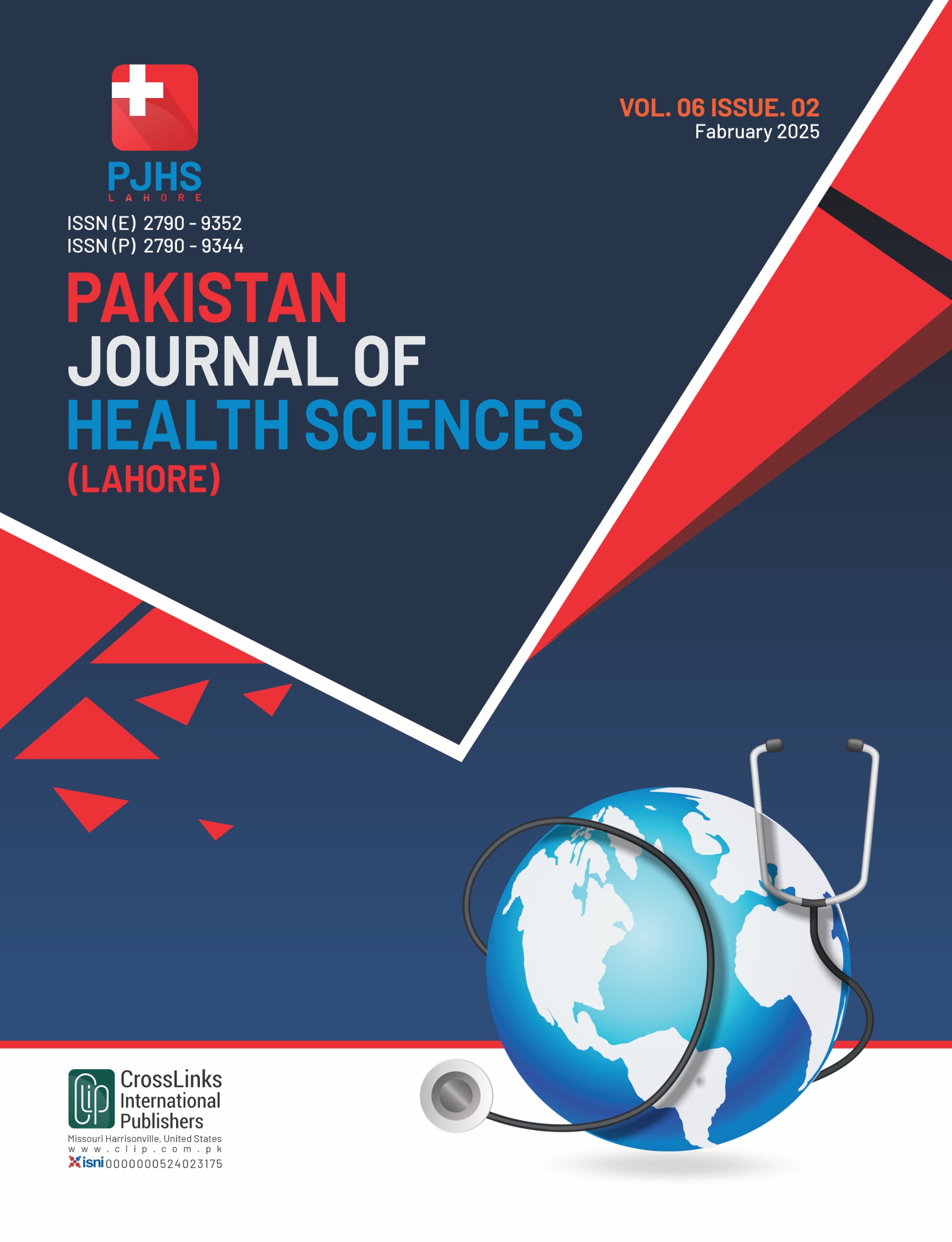Predictors of Retinopathy of Prematurity Reactivation in Pakistani Preterm Neonates After Anti-VEGF Therapy
Retinopathy of Prematurity Reactivation: Anti-VEGF Therapy
DOI:
https://doi.org/10.54393/pjhs.v6i2.3254Keywords:
Retinopathy of Prematurity, Anti-VEGF, Reactivation, Preterm Neonates, Bevacizumab, RanibizumabAbstract
Retinopathy of prematurity (ROP) is a significant cause of preventable childhood blindness, particularly in low- and middle-income countries like Pakistan, where preterm survival rates are increasing. However, the risk of disease reactivation after initial regression remains a concern, particularly in settings with limited follow-up infrastructure. Objectives: To determine the incidence and identify clinical predictors of ROP reactivation among Pakistani preterm neonates treated with intravitreal anti-VEGF therapy. Methods: This observational study was conducted at the Neonatal Nursery of the Pediatric Ward, Liaquat University of Medical and Health Sciences, Jamshoro. A total of 47 preterm neonates (≤34 weeks' gestational age and/or ≤2000 grams’ birth weight) who received anti-VEGF injections for treatment-requiring ROP were consecutively enrolled. Data on ROP zone, stage, gestational age, birth weight, and anti-VEGF agent were collected. Follow-up was performed to assess reactivation, defined as recurrence of plus disease or disease progression necessitating retreatment. Statistical analysis was performed using SPSS 25.0. Results: The mean gestational age and birth weight were 29.5 ± 1.5 weeks and 1250 ± 200 grams, respectively. ROP reactivation occurred in 8 of 47 neonates (17.0%). Zone I disease was significantly associated with higher reactivation risk (p=0.029). No significant associations were found with ROP stage, anti-VEGF type, or gestational age. Conclusions: ROP reactivation following anti-VEGF treatment occurred in 17% of cases. Zone I involvement was the only significant predictor, highlighting the need for vigilant long-term follow-up in these patients.
References
Hong EH, Shin YU, Cho H. Retinopathy of Prematurity: A Review of Epidemiology and Current Treatment Strategies. Clinical and Experimental Pediatrics. 2021 Oct; 65(3): 115. doi: 10.3345/cep.2021.00773. DOI: https://doi.org/10.3345/cep.2021.00773
Fevereiro-Martins M, Marques-Neves C, Guimarães H, Bicho M. Retinopathy of Prematurity: A Review of Pathophysiology and Signaling Pathways. Survey of Ophthalmology. 2023 Mar; 68(2): 175-210. doi: 10.1016/j.survophthal.2022.11.007. DOI: https://doi.org/10.1016/j.survophthal.2022.11.007
Awan MA, Haq A, Shaheen F, Nazir S, Choudhry S. Frequency and Outcome of Retinopathy of Prematurity at Tertiary Care Hospital in Pakistan. Journal of College of Physicians and Surgeons Pakistan. 2022 Jul; 32(7): 895-. doi: 10.29271/jcpsp.2022.07.895. DOI: https://doi.org/10.29271/jcpsp.2022.07.895
Kang HG, Choi EY, Byeon SH, Kim SS, Koh HJ, Lee SC et al. Anti-Vascular Endothelial Growth Factor Treatment of Retinopathy of Prematurity: Efficacy, Safety, And Anatomical Outcomes. Korean Journal of Ophthalmology. 2018 Nov; 32(6): 451. doi: 10.3341/kjo.2018.0011. DOI: https://doi.org/10.3341/kjo.2018.0011
Wang AT, Gupta I, Dai S. A Review of Refractive Errors Post Anti-Vascular Endothelial Growth Factor Injection and Laser Photocoagulation Treatment for Retinopathy of Prematurity. Journal of Clinical Medicine. 2025 Jan; 14(3): 810. doi: 10.3390/jcm14030810. DOI: https://doi.org/10.3390/jcm14030810
Dablouk M, Chhabra A, Masoud AT. Recurrence of Retinopathy of Prematurity Following Anti-vascular Endothelial Growth Factor (Anti-VEGF) Therapy: A Systematic Review and Meta-Analysis. Cureus. 2024 Nov; 16(11). doi: 10.7759/cureus.73286. DOI: https://doi.org/10.7759/cureus.73286
Valikodath NG, Chiang MF, Chan RP. Description and Management of Retinopathy of Prematurity Reactivation After Intravitreal Antivascular Endothelial Growth Factor Therapy. Current Opinion in Ophthalmology. 2021 Sep; 32(5): 468-74. doi: 10.1097/ICU.0000000000000786. DOI: https://doi.org/10.1097/ICU.0000000000000786
Tawfik GM, Shahein EA, Dabour SA, Hassanein D, Elshewy AM. Comparison of Intravitreal Injection of Ranibizumab Versus Bevacizumab for Treatment of Type 1 and Aggressive Retinopathy of Prematurity in Rural Egypt. A Randomized Clinical Trial. British Medical Journal Open Ophthalmology. 2022 Dec; 7(1). doi: 10.1136/bmjophth-2022-001173. DOI: https://doi.org/10.1136/bmjophth-2022-001173
Rauf A, Saigol HK, Chauhan K, Akbar S, Chaudhary NI. Prevalence of Retinopathy of Prematurity in Premature Neonates Visiting Sir Gangaram Hospital Lahore. Pakistan Journal of Medical and Health Sciences. 2023 Mar; 17(02): 206-. doi: 10.53350/pjmhs2023172206. DOI: https://doi.org/10.53350/pjmhs2023172206
Bevacizumab Eliminates the Angiogenic Threat for Retinopathy of Prematurity (Beat-ROP). The University of Texas Health Science Center, Houston. 2017.
Stahl A, Lepore D, Fielder A, Fleck B, Reynolds JD, Chiang MF et al. Ranibizumab Versus Laser Therapy for the Treatment of Very Low Birthweight Infants with Retinopathy of Prematurity (Rainbow): An Open-Label Randomized Controlled Trial. The Lancet. 2019 Oct; 394(10208): 1551-9. doi: 10.1016/S0140-6736(19)31344-3. DOI: https://doi.org/10.1016/S0140-6736(19)31344-3
Hoppe C, Holt Dg, Arnold Bf, Thinda S, Padmanabhan Sp, Oatts Jt. Structural and Refractive Outcomes of Intravitreal Ranibizumab Followed by Laser Photocoagulation for Type 1 Retinopathy of Prematurity. Journal of American Association for Pediatric Ophthalmology and Strabismus. 2022 Dec; 26(6): 305-E1. doi: 10.1016/j.jaapos.2022.08.524. DOI: https://doi.org/10.1016/j.jaapos.2022.08.524
Ozdemir HB, Ozdek S, Tunay ZO, Bayramoglu SE, Sukgen EA, Kir N. Clinical Characteristics and Treatment Response of Treatment Requiring Retinopathy of Prematurity (ROP) in Big Premature Infants in Turkiye: Big-ROP Study Group Report No 2 (Big-Rop Study). British Medical Journal Open Ophthalmology. 2025 Jun; 10(1). doi: 10.1136/bmjophth-2024-002081. DOI: https://doi.org/10.1136/bmjophth-2024-002081
Mannan MA. Frequency and Risk Factors of Retinopathy of Prematurity Among Preterm Neonates in A Tertiary Care Hospital of Bangladesh. Journal of Clinical Pediatrics and Neonatology. 2023 Nov; 3(1): 11-7. doi: 10.46439/pediatrics.3.021. DOI: https://doi.org/10.46439/pediatrics.3.021
Patel NA, Acaba-Berrocal LA, Hoyek S, Fan KC, Martinez-Castellanos MA, Baumal CR et al. Comparison in Retreatments Between Bevacizumab and Ranibizumab Intravitreal Injections for Retinopathy of Prematurity: A Multicenter Study. Ophthalmology. 2023 Apr; 130(4): 373-8. doi: 10.1016/j.ophtha.2022.11.012. DOI: https://doi.org/10.1016/j.ophtha.2022.11.012
Huang YC, Hsu KH, Chu SM, Chiang MC, Lien R, Chen KJ et al. Respiratory Outcomes in Preterm Infants Following Intravitreal Bevacizumab for Retinopathy of Prematurity–A 10-Year Matched Case Study. Eye. 2023 Dec; 37(17): 3675-81. doi: 10.1038/s41433-023-02579-9. DOI: https://doi.org/10.1038/s41433-023-02579-9
Wallace DK, Dean TW, Hartnett ME, Kong L, Smith LE, Hubbard GB et al. A Dosing Study of Bevacizumab for Retinopathy of Prematurity: Late Recurrences and Additional Treatments. Ophthalmology. 2018 Dec; 125(12): 1961-6. doi: 10.1016/j.ophtha.2018.05.001. DOI: https://doi.org/10.1016/j.ophtha.2018.05.001
Gangwe AB, Ekumankama CB, Singh A, Parchand SM, Agrawal D, Azad RV. Comparison of Reactivation Between Ranibizumab and Bevacizumab in Aggressive Retinopathy of Prematurity: A Retrospective Case Series. Indian Journal of Ophthalmology. 2025 Jan; 73(Suppl 1): S119-25. doi: 10.4103/IJO.IJO_161_24. DOI: https://doi.org/10.4103/IJO.IJO_161_24
Milani AE, Arasteh A, Saeedi-Maleki Z, Niyousha MR, Sahebazamani MA, Brumandpur F. Evaluating the Causes of Retinopathy of Prematurity Relapse Following Intravitreal Bevacizumab Injection. BioMed Central Ophthalmology. 2024 Jun; 24(1): 265. doi: 10.1186/s12886-024-03528-0. DOI: https://doi.org/10.1186/s12886-024-03528-0
Dani C, Coviello C, Panin F, Frosini S, Costa S, Purcaro V et al. Incidence and Risk Factors of Retinopathy of Prematurity in an Italian Cohort of Preterm Infants. Italian Journal of Pediatrics. 2021 Mar; 47(1): 64. doi: 10.1186/s13052-021-01011-w. DOI: https://doi.org/10.1186/s13052-021-01011-w
Ling KP, Liao PJ, Wang NK, Chao AN, Chen KJ, Chen TL et al. Rates and Risk Factors for Recurrence of Retinopathy of Prematurity After Laser or Intravitreal Anti–Vascular Endothelial Growth Factor Monotherapy. Retina. 2020 Sep; 40(9): 1793-803. doi: 10.1097/IAE.0000000000002663. DOI: https://doi.org/10.1097/IAE.0000000000002663
Downloads
Published
How to Cite
Issue
Section
License
Copyright (c) 2025 Pakistan Journal of Health Sciences

This work is licensed under a Creative Commons Attribution 4.0 International License.
This is an open-access journal and all the published articles / items are distributed under the terms of the Creative Commons Attribution License, which permits unrestricted use, distribution, and reproduction in any medium, provided the original author and source are credited. For comments













